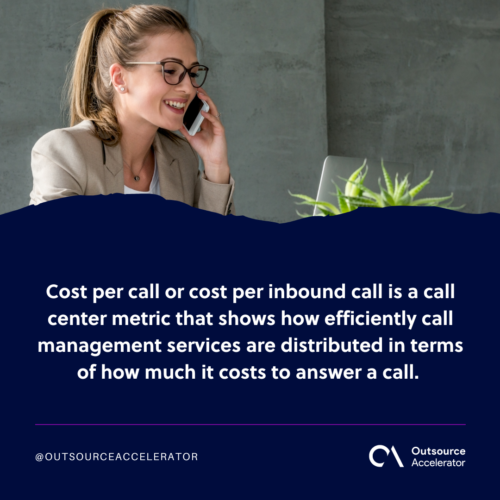Cost per Call
Definition
What is the cost per call?
Cost per call is also known as cost per inbound call, and it is a fundamental metric in call center management.
It provides insight into the efficiency of call-handling services relative to the expenses incurred for each answered call.
Call center operators are consistently engaged in the pursuit of cost-reduction strategies while maintaining optimal levels of customer support.
Calculating the cost per call is the initial and crucial step in achieving this delicate equilibrium. This metric encompasses the overall expenses of managing all calls or communications over a specified period, making it a vital key performance indicator (KPI).
Speaking of KPI in cost per call—call center managers routinely leverage this to assess the quality of their call center operations.
By understanding the cost per call, organizations can make informed decisions to enhance operational efficiency, allocate resources effectively, and improve the overall performance of their call center services.

How to reduce cost per call?
Reducing the cost per call is a critical objective in every contact center. A comprehensive understanding of various factors, such as call volume, total call center costs, and fully loaded costs, is essential to achieve this.
Call volume directly influences the total cost, encompassing operational expenses and fully loaded costs associated with each customer interaction.
To calculate cost per call accurately, organizations must consider immediate operational and fully loaded costs, including additional factors like overhead, infrastructure, and personnel.
By meticulously analyzing and optimizing these components, contact centers can implement strategies to minimize the total cost per call, ensuring a more cost-effective and sustainable operation.
This approach allows contact center managers to balance cost reduction and maintaining the quality of customer support services.
Here are some of the effective ways to start reducing the cost per call:
Optimize call routing
Call routing optimization is crucial for minimizing costs and improving customer experience.
By employing intelligent call routing systems, calls can be directed to the most appropriate agents based on skill set, availability, and historical performance.
This ensures that each call is handled efficiently, reducing call duration and lowering the overall cost per call.
Implement self-service options
Integrating self-service options empowers customers to resolve queries independently, reducing the need for agent intervention.
Interactive voice response (IVR) systems, online FAQs, and automated processes enable users to find information and complete routine tasks without agent assistance.
This enhances customer satisfaction and significantly reduces the resources required for handling routine inquiries, contributing to a lower cost per call.
Train agents for efficiency
Investing in agent training programs enhances efficiency and reduces the time spent on each call. Agents should have the necessary skills to handle various issues promptly and accurately.
Ongoing training programs can focus on communication skills, product knowledge, and problem-solving abilities. This ensures that agents can swiftly address customer concerns, lowering the overall cost of each customer interaction.
Use predictive analytics
Predictive analytics is key in forecasting call volumes and understanding customer behavior patterns.
By leveraging historical data and advanced analytics tools, call centers can anticipate peak call times, enabling better staffing allocation.
This proactive approach prevents overstaffing and ensures that the right resources are available during peak demand, optimizing operational costs and improving overall call center efficiency.
Utilize cloud-based communication solutions
Migrating to cloud-based communication solutions offers several advantages for cost reduction.
Cloud platforms provide scalability, allowing call centers to adjust resources based on demand. Additionally, they often come with built-in features like automatic updates and maintenance, reducing the burden on IT teams.
Cloud-based solutions also facilitate remote work, enabling organizations to tap into a broader talent pool while potentially reducing overhead costs associated with physical infrastructure.
This shift to the cloud enhances flexibility and cost-effectiveness in managing call center operations.
Other ways to reduce cost per call:
- Improve agent recruiting, preparation, and coaching. One of the most effective ways to reduce call costs while improving customer service efficiency is to ensure that the agents have the necessary skills, experience, and resources to meet the customer’s needs.
- Use call monitoring to keep things under control. Call center managers must track calls and provide positive input to agents to enhance their performance. It will guarantee better FCR and low AHT while lowering the cost per call.
- Make use of call center software that is optimized. If you want your team to work well, you must provide them with the necessary resources. If you could only make one investment to reduce cost per call, it would be integrated call center software.







 Independent
Independent




